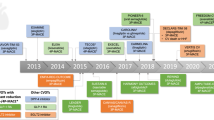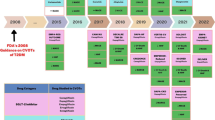Abstract
Current guidelines for the management of hyperglycemia recommend the use of agents with proven cardiovascular (CV) benefit in patients with type 2 diabetes (T2D) and established CV disease. Although both glucagon-like peptide 1 receptor agonists (GLP-1 RA) and sodium-glucose co-transporter 2 inhibitors (SGLT2i) have been shown to reduce the risk of major adverse CV events (MACE) in high-risk populations with T2D, the ideal choice between the two classes for people with coronary artery disease remains controversial. SGLT2i reduce CV risk primarily through hemodynamic effects and changes in energy metabolism, making them the first choice in cases where heart failure or chronic kidney disease predominates. On the other hand, GLP-1 RA exert powerful anti-atherogenic properties that are the main drivers of their cardioprotection, and seem to have a consistent benefit in the atherosclerotic components of MACE. However, most people with diabetes and CV disease could take advantage of the complementary effects of the two drug categories on glycemic control, body weight, and diabetic complications. Future mechanistic studies and clinical head-to-head trials are expected to shed more light on this intriguing clinical dilemma and provide clear guidance for daily practice.

Similar content being viewed by others
References
White EB. Essays of E.B. White. Gloucester: Peter Smith Pub Inc; 2001.
Einarson TR, Acs A, Ludwig C, et al. Prevalence of cardiovascular disease in type 2 diabetes: a systematic literature review of scientific evidence from across the world in 2007–2017. Cardiovasc Diabetol. 2018;17:83.
Severino P, D’Amato A, Pucci M, et al. Ischemic heart disease pathophysiology paradigms overview: from plaque activation to microvascular dysfunction. Int J Mol Sci. 2020;21:8118.
Cosentino F, Grant PJ, Aboyans V, et al. 2019 ESC Guidelines on diabetes, pre-diabetes, and cardiovascular diseases developed in collaboration with the EASD. Eur Heart J. 2020;41:255–323.
American Diabetes Association. 9. Pharmacologic approaches to glycemic treatment: standards of medical care in diabetes-2022. Diabetes Care. 2022;45:S125–43.
Marso SP, Bain SC, Consoli A, et al. Semaglutide and cardiovascular outcomes in patients with type 2 diabetes. N Engl J Med. 2016;375:1834–44.
Gerstein HC, Colhoun HM, Dagenais GR, et al. Dulaglutide and cardiovascular outcomes in type 2 diabetes (REWIND): a double-blind, randomised placebo-controlled trial. Lancet. 2019;394:121–30.
Hernandez AF, Green JB, Janmohamed S, et al. Albiglutide and cardiovascular outcomes in patients with type 2 diabetes and cardiovascular disease (Harmony Outcomes): a double-blind, randomised placebo-controlled trial. Lancet. 2018;392:1519–29.
Koufakis T, Mustafa OG, Tsimihodimos V, et al. Insights into the results of sotagliflozin cardiovascular outcome trials: is dual inhibition the cherry on the cake of cardiorenal protection? Drugs. 2021;81:1365–71.
Zinman B, Wanner C, Lachin JM, et al. Empagliflozin, cardiovascular outcomes, and mortality in type 2 diabetes. N Engl J Med. 2015;373:2117–28.
Chen TH, Li YR, Chen SW, et al. Sodium-glucose cotransporter 2 inhibitor versus metformin as first-line therapy in patients with type 2 diabetes mellitus: a multi-institution database study. Cardiovasc Diabetol. 2020;19:189.
Imprialos KP, Boutari C, Stavropoulos K, et al. Stroke paradox with SGLT-2 inhibitors: a play of chance or a viscosity-mediated reality? J Neurol Neurosurg Psychiatry. 2017;88:249–53.
Palmer SC, Tendal B, Mustafa RA, et al. Sodium-glucose cotransporter protein-2 (SGLT-2) inhibitors and glucagon-like peptide-1 (GLP-1) receptor agonists for type 2 diabetes: systematic review and network meta-analysis of randomised controlled trials. BMJ. 2021;372:m4573.
Arnott C, Li Q, Kang A, et al. Sodium-glucose cotransporter 2 inhibition for the prevention of cardiovascular events in patients with type 2 diabetes mellitus: a systematic review and meta-analysis. J Am Heart Assoc. 2020;9:e014908.
Andrikou E, Tsioufis C, Andrikou I, et al. GLP-1 receptor agonists and cardiovascular outcome trials: an update. Hellenic J Cardiol. 2019;60:347–51.
Holman RR, Bethel MA, Mentz RJ, et al. Effects of once-weekly exenatide on cardiovascular outcomes in type 2 diabetes. N Engl J Med. 2021;377:1228–39.
Koufakis T, Papanas N, Dimitriadis G, et al. Interpreting the results of the VERTIS-CV trial: Is this the end of the “class effect” perspective? J Diabetes. 2020;12:942–5.
Inzucchi SE, Zinman B, Fitchett D, et al. How does empagliflozin reduce cardiovascular mortality? Insights from a mediation analysis of the EMPA-REG OUTCOME trial. Diabetes Care. 2018;41:356–63.
Bhatt DL, Szarek M, Steg PG, et al. Sotagliflozin in patients with diabetes and recent worsening heart failure. N Engl J Med. 2021;384:117–28.
Rakipovski G, Rolin B, Nøhr J, et al. The GLP-1 analogs liraglutide and semaglutide reduce atherosclerosis in ApoE-/- and LDLr-/- mice by a mechanism that includes inflammatory pathways. JACC Basic Transl Sci. 2018;3:844–57.
Buse JB, Bain SC, Mann JFE, et al. Cardiovascular risk reduction with liraglutide: an exploratory mediation analysis of the LEADER trial. Diabetes Care. 2020;43:1546–52.
Song X, Jia H, Jiang Y, et al. Anti-atherosclerotic effects of the glucagon-like peptide-1 (GLP-1) based therapies in patients with type 2 diabetes mellitus: a meta-analysis. Sci Rep. 2015;5:10202.
Kapadia P, Bikkina P, Landicho MA, et al. Effect of anti-hyperglycemic drugs on endoplasmic reticulum (ER) stress in human coronary artery endothelial cells. Eur J Pharmacol. 2021;907:174249.
Ornish D, Brown SE, Scherwitz LW, et al. Can lifestyle changes reverse coronary heart disease? The lifestyle heart trial. Lancet. 1990;336:129–33.
Weeda ER, Muraoka AK, Brock MD, et al. Medication adherence to injectable glucagon-like peptide-1 (GLP-1) receptor agonists dosed once weekly vs once daily in patients with type 2 diabetes: a meta-analysis. Int J Clin Pract. 2021;75:e14060.
Mooradian AD. Evidence-based cardiovascular risk management in diabetes. Am J Cardiovasc Drugs. 2019;19:439–48.
Koufakis T, Papanas N, Zebekakis P, et al. Treatment options following metformin in primary prevention populations with type 2 diabetes: which is the right road to take? Expert Rev Clin Pharmacol. 2021;14:1189–92.
Acknowledgements
None.
Author information
Authors and Affiliations
Corresponding author
Ethics declarations
Funding
No external funds were used in the preparation of this article.
Conflict of interest
TK has received honoraria for lectures from AstraZeneca, Boehringer Ingelheim, Pharmaserve Lilly, and Novo Nordisk and for advisory boards from Novo Nordisk, and has participated in studies sponsored by Eli-Lilly. ENL has participated in educational, research, and advisory activities sponsored by AstraZeneca, MSD, Lilly, Bayer, Amgen, Sanofi, Boehringer Ingelheim, Novartis, Novo Nordisk, and Servier. KK has received honoraria for lectures/advisory boards and research support from Astra Zeneca, Boehringer Ingelheim, Pharmaserve Lilly, Sanofi-Aventis, ELPEN, MSD, and Novo Nordisk.
Author contributions
TK reviewed the literature and drafted the first version of the manuscript. ENL and KK reviewed the literature and edited the manuscript. All authors have read and approved the final version of the manuscript.
Ethics approval and consent to participate
Not applicable.
Informed consent
Not applicable.
Consent for publication
Not applicable.
Availability of data and materials
Not applicable.
Research involving human participants and/or animals
Not applicable.
Code availability
Not applicable.
Rights and permissions
About this article
Cite this article
Koufakis, T., Liberopoulos, E.N. & Kotsa, K. A Horse, a Jockey, and a Therapeutic Dilemma: Choosing the Best Option for a Patient with Diabetes and Coronary Artery Disease. Am J Cardiovasc Drugs 22, 357–361 (2022). https://doi.org/10.1007/s40256-022-00527-8
Accepted:
Published:
Issue Date:
DOI: https://doi.org/10.1007/s40256-022-00527-8




